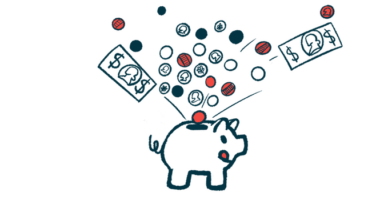Roche’s Cevostamab Leads to Durable, Deep Responses in Heavily Pre-Treated Patients

Cevostamab (BFCR4350A), a bispecific antibody developed by Roche, induces durable and deep responses in heavily pre-treated patients with relapsed or refractory multiple myeloma, according to early data from a Phase 1 trial.
Preliminary data from the trial, called GO39775 (NCT03275103), also showed cevostamab had a manageable safety and toxicity profile when given in a single step-up dosing manner.
“Our data reflect our ongoing commitment to following the science and improving the lives of patients with some of the most difficult-to-treat blood disorders,” Levi Garraway, MD, PhD, chief medical officer and head of global product development at Roche, said in a press release.
These early findings were reported in an oral presentation, titled “Initial Clinical Activity and Safety of BFCR4350A, a FcRH5/CD3 T-Cell-Engaging Bispecific Antibody, in Relapsed/Refractory Multiple Myeloma,” at the 62nd American Society of Hematology (ASH) Annual Meeting and Exposition, held online Dec. 5–8.
Cevostamab is a new bispecific antibody that simultaneously binds to a portion of the Fc receptor-like protein 5 (FcRH5), a protein receptor found in nearly all myeloma cells, and the CD3 protein on immune T-cells. By doing so, cevostamab is expected to bring cancer and immune cells closer together and to improve immune responses.
The dose-escalation GO39775 trial is assessing the safety, tolerability, and anti-tumor activity of cevostamab in relapsed or refractory (resistant) myeloma patients. The trial, which is expected to include around 130 patients, is currently enrolling participants at 21 sites across the U.S., Australia, Canada, and Europe. More information about trial contacts and recruiting sites can be found here.
During the study, participants will be assigned to receive one of two dosing regimens of cevostamab, which will be administered intravenously (into the vein) on a 21-day cycle, for up to 17 cycles (approximately one year).
Those in the single step-up dosing group will receive an initial step-up dose on the first day of the first cycle, followed by the therapy’s target dose on the eighth day of cycle 1. The target dose will then be administered on the first day of each subsequent cycle.
This dosing approach aims to lower the risk of cytokine release syndrome (CRS), a serious immune reaction that can be triggered by certain forms of cancer immunotherapy.
In contrast, those in the multi step-up dosing group will receive two step-up doses — one on the first day of cycle 1 and another on the eighth day of cycle 1 — followed by a target dose on day 15 of the first cycle. As in the previous single step-up dosing regimen, the target dose will be given on the first day of each subsequent cycle.
At the meeting, Roche presented early data from a subset of patients who enrolled in the single step-up dosing group of the trial.
As of April 13, 2020, a total of 51 patients, ages 33–80 (median age 62), who had received a median of six prior lines of therapy, had enrolled in the trial’s single step-up dosing group.
More than half (66.7%) of the patients had triple refractory disease, meaning they failed to respond to at least three different therapies, including one immunomodulatory agent, one proteasome inhibitor, an one anti-CD38 antibody. Nearly all (94.1%) had failed to respond to their last therapy regimen.
As of the cut-off date, 46 of the 51 patients enrolled were eligible for efficacy analyses. Responses were observed in 15 of the 29 patients (51.7%) who received cevostamab at the active dose level (3.6 mg step-up dose/20 mg target dose) and above.
From those who responded to treatment, three attained stringent complete responses, three complete responses, four very good partial responses, and five partial responses.
Complete responses refer to total cancer eradication, while partial responses refer to partial cancer elimination. Very good partial responses and stringent complete responses are stronger types of partial and complete responses, respectively.
Responses to cevostamab also were observed in patients with high-risk disease (nine out of 17), as well as in those with triple refractory disease (10 out of 20), when the therapy was given at the active dose level or above. Response duration is still being determined, with six of the 15 patients who responded to treatment still maintaining a response lasting more than six months at the cut-off date.
After a median follow-up of 6.2 months, 49 of the 51 patients enrolled in the study had experienced at least one treatment-related side effect. Observed in 74.5% of the patients, CRS was the most common treatment-related side effect. But most cases of cytokine response syndrome were only mild (39.2%) or moderate (33.3%) in severity, resolved within two days (84.5%), and occurred during the first cycle of treatment (in 38 patients).
The most common severe to life-threatening treatment-related side effects observed included low white blood cell counts (11.8%), neutropenia (9.8%), anemia (5.9%), and low platelet counts (5.9%). Of note, neutropenia is an abnormally low number of neutrophils, a type of white blood cell, in the blood. One patient discontinued treatment due to side effects. No deaths were reported in the study so far.
“BFCR4350A monotherapy demonstrates promising activity in heavily pre-treated [myeloma patients] with deep and durable responses observed in [those with high risk], triple-class refractory disease,” the investigators wrote.
“Toxicity was manageable, with … single step-up dosing effectively mitigating the risk for severe CRS and allowing escalation to clinically active doses,” they added.
The company also presented preliminary biomarker data from the same subset of patients that further supports cevostamab’s mode of action. These findings were featured in the poster, “Early Pharmacodynamic Changes in T-Cell Activation, Proliferation, and Cytokine Production Confirm the Mode of Action of BFCR4350A, a FcRH5/CD3 T-Cell-Engaging Bispecific Antibody, in Patients with Relapsed/Refractory Multiple Myeloma.”
Data from these analyses revealed that myeloma cells in all 51 patients were positive for FcRH5. Patient T-cells started to become active 24 hours after the first cevostamab infusion, and reached a maximum proliferation at the eighth day of cycle 1.
Increased levels of the pro-inflammatory cytokine interleukin-6 (IL-6) were detected in the first 24 hours after patients received their initial dose. This increase in IL-6 levels also was found to be associated with a higher risk of CRS. Of note, cytokines are molecules that mediate immune and inflammatory responses.
However, “step-up dosing mitigated the risk for severe CRS, as evidenced by lower IL-6 levels after the target dose” of the therapy was administered on the eighth day of the first cycle in 82% of the patients.
“We demonstrated that early … changes in T-cell activation, proliferation, and cytokine production confirm the [mechanism of action] of BFCR4350A and support … step-up dosing for CRS mitigation,” the investigators wrote.
“Additional analyses are ongoing to establish BFCR4350A response predictors and to better characterize the populations that are likely to benefit [from treatment],” they wrote.






